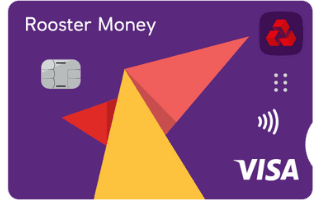
If GoHenry isn’t exactly what you’re after, this guide takes a look at some similar alternatives out there in the UK market.
Top alternatives to GoHenry
- Revolut <18 Account – Good for those looking for no monthly fee.
- NatWest Rooster Money – Good for setting and rewarding chores around the house.
- Starling Kite – Another good option for those looking for no monthly fee.
- nimbl – A good option for those with young children, with cards available for those as young as 6.
- Osper – Good for those looking for similar features and options as GoHenry.
- HyperJar – Good for those looking for a card with no monthly or transaction fees.
Revolut <18 Account.
That’s right, ever-popular challenger brand Revolut operates a banking account for kids as well as us adults. Called Revolut <18 Account, it’s aimed at children aged from 6.
Like GoHenry, Revolut <18 Account comes with a mobile app and a physical payment card. The parent also tops up the money held in the child’s account and can set controls on how much is spent and where.
The big plus of Revolut <18 Account is that there’s no monthly fee or any charges to top up the child’s account – but the big catch is that as a parent you already have to be a Revolut account holder in order to open the Junior version. You can compare Revolut accounts for adults here. There is currently a £20 sign-up bonus on offer.
Although Revolut <18 Account is free to set up, other transaction fees apply, and will mirror those of whatever type of Revolut account the parent has (e.g. Standard, Premium, Metal or Ultra).
The exception to this is around the Junior card. While spending online or in-store is free, there are other fees.
Get the low-down on it in our Revolut <18 Account review.
NatWest Rooster Money
Rooster Money has a big emphasis on keeping track of pocket money – and the chores that kids do to earn it.Rooster Money comes in two parts. The first is an app, designed for children as young as 4, to earn stars for small jobs they’ve done or things they’ve achieved. They can then see these stars add up and turn into rewards, such as their weekly pocket money – but you’ll have to hand over the physical cash at this stage, if you’re just using the app to track stars and teach good habits.
If you want the banking-style element of Rooster Money you’ll need to order its prepaid card, which comes with the usual parental account and spending control features. This payment card links up with the app, although your child has to be 6 years old to use the card.
Fees for using Rooster Money vary from a free basic version of the app to a full subscription complete with a prepaid card and no spending or ATM fees, costing £1.99 a month. For NatWest Group customers, the card is free. You can compare NatWest current accounts here.
To view the specific features and fee plans on offer, visit our Rooster Money review page.
Starling Kite
In a similar offering to Revolut <18 Account, Starling Kite is a debit card for kids that you can only order if you are a parent (or guardian) and already have a Starling current account or joint account. You can learn more about Starling’s account for adults here.
Starling Kite is designed for children aged 6–15, who can use it to spend money from a separate prepaid account, which is set up and topped up by their parents through the Starling banking app. The parents can keep an eye on where and when their children are spending money through real-time notifications, and they can also set daily spending limits or block certain merchants altogether.
Kids now also get their own version of the Starling app, so they can check out their transaction history and get notifications when they spend.
Starling Kite is comparable to the cost of most other kids’ prepaid cards, and it comes with unlimited free top-ups.
Find out more in our dedicated Starling Kite review.
nimbl
Another financial service aiming to help parents show their children how to save, budget and be organised with their money is nimbl.
It follows the familiar structure of a financial app linked to a prepaid card, involving a parental account linked to a child’s account. Children aged 6–18 can use the account, and the associated payment card is a prepaid debit Mastercard.
A parent can see what their child is spending by receiving real-time notifications of card transactions through the app, and like with many similar digital providers, they are able to block certain merchants altogether.
With nimbl, the annual fee is £32 for the first child account. Additional cards on your account cost £27 a year. But purchases, top ups and ATM withdrawals are all free, which is one of the few obvious differences between nimbl and GoHenry.
For a full run-down of nimbl and how to use it, check out our in-depth nimbl review.
Osper
Osper also bears a close resemblance to GoHenry, so it could be the alternative you’re looking for.It comes with all of the features you’d expect from this type of money management app aimed at families. There’s the linked parent and child accounts, a digital app, a prepaid Mastercard, spending controls and text alerts for any declined transactions.
Like with most of the providers we’ve mentioned here, with Osper, parents can top up their kid’s funds, get an oversight of what they’ve spent the money on, freeze the payment card if it gets mislaid, and be assured that there’s no possibility of the child’s account going overdrawn.
Aimed at children aged 8 and over, Osper is free for the first month, but it will cost parents £1.95 (with Finder’s promo code) per child, per month after that.
Discover more about what’s on offer in our Osper review.
HyperJar
HyperJar is another provider to have hit the kids’ prepaid card market, following its original 2020 debut as a prepaid card and budgeting app for adults.
The HyperJar kids’ card is available for children aged 6–17 and it works through their parents’ HyperJar account. The parent basically sets up one of their “jars” (money pots) as a spending account for their child, which the prepaid card is then linked to.
The child can then use the card to spend in-store and online, as well as withdraw cash from ATMs. Parents can see all of their transactions and set spending limits. They can also set up a savings pot, if their child wants to set aside some of the money they’ve been given to save up for something specific.
There’s no cost for the HyperJar kids’ card (or fees for using it to spend in the UK or abroad), but parents can only put money on it by shifting funds into that jar from their own HyperJar account.
Read all about it in our HyperJar kids’ card review.
Putting your kids in control of their finances is a great way to give them a financial education and to get them thinking about money from a young age. There are lots of ways to do this, so get them involved with the process. If a spending app isn’t the right choice, a free children’s bank account or savings account – some of which pay 5% interest – might be a better option.”
Bottom line
GoHenry is one of the most popular kids’ spending card and app services in the UK, but if you’re looking for an alternative then there are many similar options out there, as outlined in our guide above. Another different route to getting a payment card for your child would be to open a children’s bank account, and our separate guide explores the differences between a debit card that comes with a kids’ bank account and one that comes with a kids’ spending app.
Sources
More guides on Finder
-
Are parents the real money influencers?
The message from kids is clear – they want money lessons, and they want them now. This research reveals how parents are stepping in to fill the gap. (Paid content)
-
Monzo for Under 16s review
Monzo’s long-awaited children’s account has launched. We’ve reviewed it to see how it stacks up against the competition.
-
Virgin Money children’s bank account review
Find out more about the children’s accounts available from Virgin Money.
-
Ulster Bank children’s bank account review
Find out more about the children’s accounts available from Ulster Bank.
-
GoHenry vs NatWest Rooster Money (with a £20 pocket money bonus!)
We compare GoHenry and NatWest Rooster Money to see which is better for your child.
-
GoHenry vs nimbl (with a £20 pocket money bonus!)
We compare GoHenry and nimbl to see which could work better for you and your child.
-
GoHenry vs HyperJar Kids (with a £20 pocket money bonus!)
We compare GoHenry and HyperJar Kids to see which could work better for you and your child.
-
Monzo teen account review: For teens 16-17
We reveal the pros and cons of the Monzo teen account.
-
GoHenry promo, discount and referral codes for December 2025
New to GoHenry? See if you can keep some more money in your pocket with our promo codes and special offers.
-
nimbl review
With nimbl, children as young as 6 can use a card and manage their money through an app. We cover how it works, the fees, and the pros and cons for parents.

